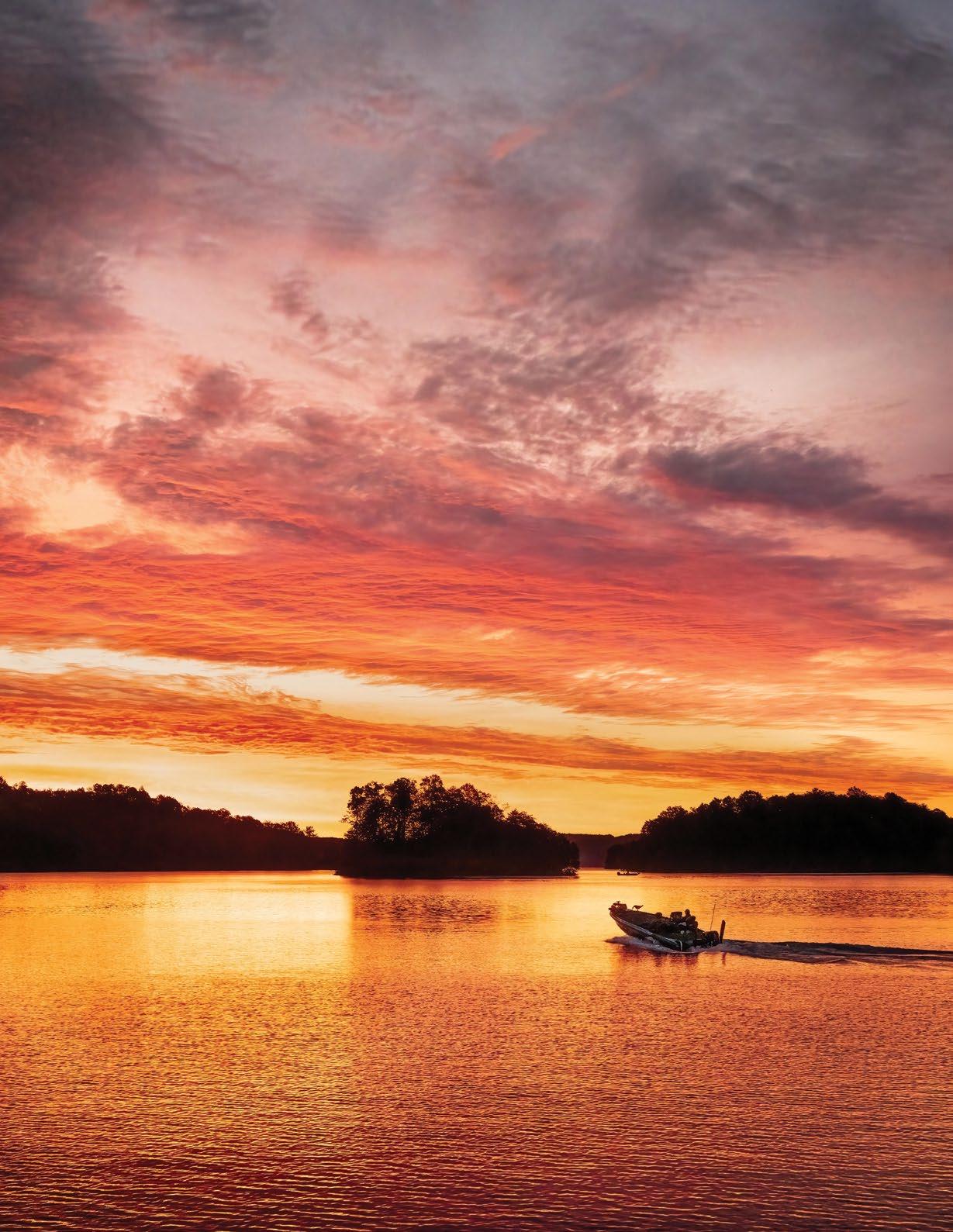
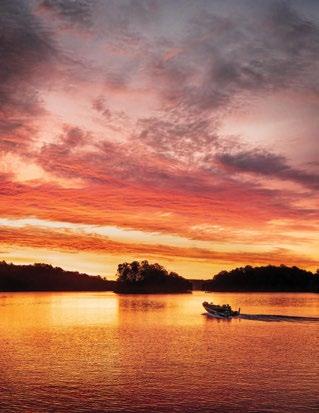





By Dale Wilde, President, FOLKS
For this fall edition of KEOWEE magazine, I wanted to recap the efforts to date by board members and volunteers. It has been a very busy year for FOLKS, but not in the same way as in years past—this year our focus was more on stakeholder events and education.
In January, FOLKS was one of the 13 signatories of the Duke Energy Relicensing Agreement for the Bad Creek Pumped Storage Project FERC No. 2740, which also supported the proposed Bad Creek II Pumped Storage Project that would double the energy output from that reservoir. This was the cumulative effort of years of studies and meetings. The relicense for the Bad Creek Pumped Storage Project, if approved by FERC, will ensure that project will remain in operation for 50 additional years. Bad Creek provides a vital renewable energy resource in this region. This agreement also included several important understandings for funding specific projects, for conservation groups and for agencies. Projects include a Bad Creek Visitors Center; a Foothills Trail interpretive exhibit; continued maintenance of the 43-mile-long Duke Energy section of the Foothills Trail; and four no cost leases to SCDNR for the land conservation agreements of nearly 2,000 acres to support hunting, wildlife viewing, and public recreation. The agreement will also provide $500,000 in funding for the KeoweeToxaway Habitat Enhancement Program (KTHEP) fund; financial support for SCDNR’s fisheries enhancement and management; $500,000 in funding to the Lake Keowee Source Water Protection Team; and $2.5 million to the Wildlife Enhancement Program. Should Bad Creek II also be approved, additional monies will be allocated to the KTHEP program and LKSWPT. This Relicensing Agreement provides vital funding in the watershed.
numerous other stakeholders in the Upstate. This updated SMP will provide key changes in the characterization of the 377 miles of shoreline and will be used for decisions on usage and permitting by Duke Energy. This was a significant effort by stakeholders to undertake and provide consensus on proposed changes. Duke Energy will be presenting this updated SMP at an upcoming event at World of Energy.
Another substantial effort was our 2025 Speaker Series chaired by Tony Gody and sponsored by the Cason Group. We held monthly speaker series events for seven months on the following topics: Boating on Lake Keowee, Energy Production: Nuclear and Hydro, History of the Area, The Foothills Trail, Water Resources and Rain Gardens, and the Oconee County Sheriff’s Office vision, mission and core values. Each event had a great turnout, and we gained new members! Tony, Melissa and the Cason Group did an outstanding job with each event.
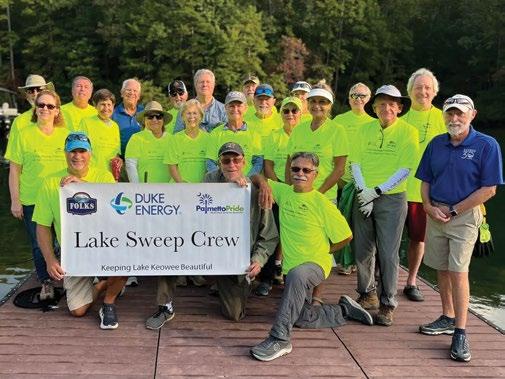
FOLKS also undertook a slightly scaled-back Spring Lake Sweep as we recognized that so much of the lake is developed and the spring cleanups have resulted in less bags of trash collected. Thus, we focused on just select, troublesome areas. We are having our Fall Lake Sweep throughout September, and we hope to have a new Lake Sweep commodore to replace our long-time commodore Scott Calderwood. The Island Keepers also had a very successful summer cleaning up the islands on the lake. We appreciate all those that turned out for our Lake Sweeps and Island cleanups. We could not do this without the dedicated support of our volunteers.
This year Duke Energy also invited FOLKS to participate in the review and updating of the Keowee Toxaway Shoreline Management Plan (SMP) along with
I am very proud of the current FOLKS Board and the efforts they have all put forth this year to make it such a great success. The board is an incredible group of talented and successful lake-loving residents. I look forward to seeing what great things they do next year and in years to come. Thank you for your support of FOLKS!
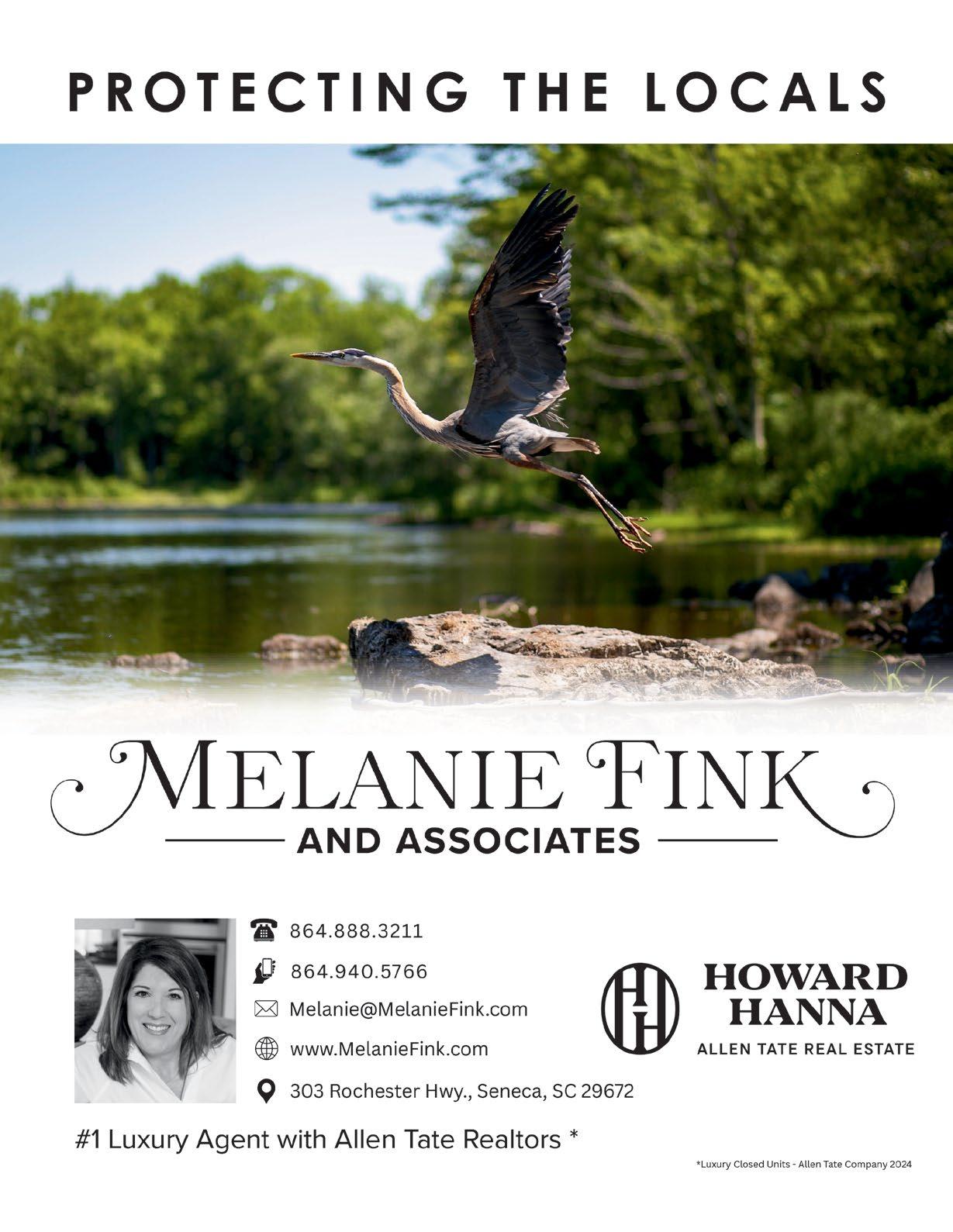

Friends Of Lake Keowee Society (FOLKS) is proud to provide financial support for college, to high school students who show a strong interest in natural resource conservation and the environment. Candidates will monitor the water quality of a chosen stream for a six month period and then make a presentation of their findings to members of the FOLKS board.
The Jack Lewis Watershed Stewardship Scholarship is named in honor of Jack Lewis, whose time with the Friends Of Lake Keowee Society spanned more than 20 years.
Jack’s enthusiastic attitude, keen sense of duty, and a good heart were evident throughout his tenure.
Applications for the 2025-2026 program are available now. Scan the QR code for more information.
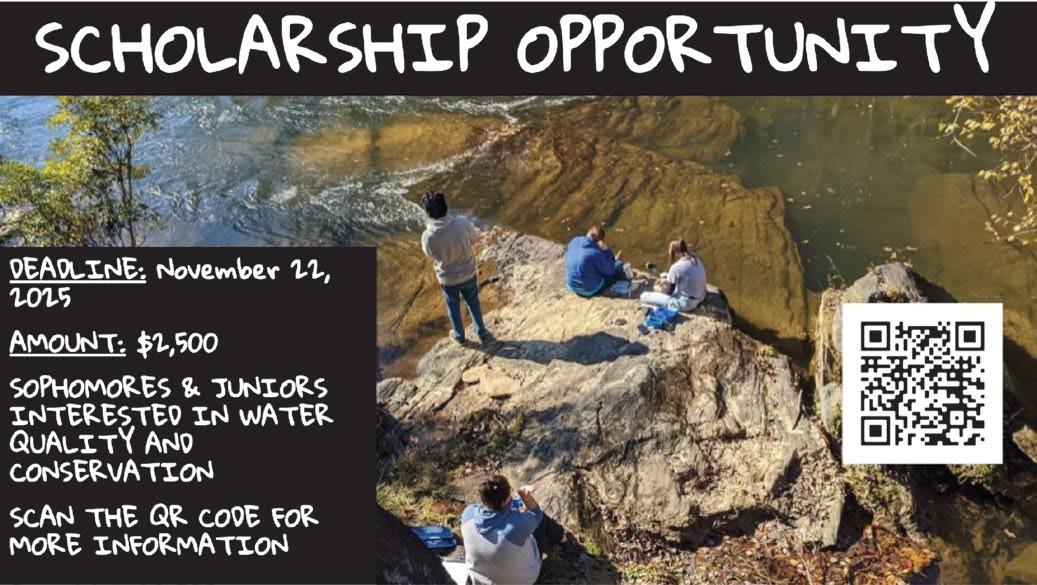
D. Beau Sylvester, J.D. serves on the Friends of Lake Keowee Society Board and is a Global Real Estate Advisor with Herlong & Associates | Sotheby’s International Realty. He and his wife of 31 years, Laura, moved from Nashville to Lake Keowee in 2023, drawn by the community, the water, and the Upstate’s outdoor lifestyle. They are proud parents of three sons—Christian, Patrick, and Colin.

senior corporate roles. He is known for an advocacy-first approach, transparent communication, and data-driven strategy.
Beau brings 30+ years of experience across real estate, law, and corporate leadership, including sixteen years as a litigation attorney and thirteen years in
As a FOLKS board member, Beau is committed to responsible growth, clean water initiatives, and education that helps residents enjoy Lake Keowee while protecting it for future generations. When he’s not advising clients or volunteering, Beau can be found playing tennis, hiking in the nearby mountains, or spending time on the lake with family and friends.
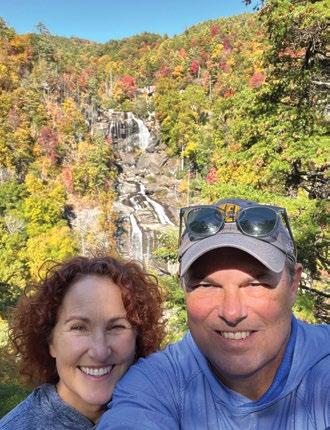
OCT. 4
Friends of Jocassee Paddle Splash
Devil’s Fork State Park
From 7:30 am until 12:00 pm Register at friendsofjocassee.org
OCT. 9
SCNPS Upstate Chapter Fall Native Plant Sale
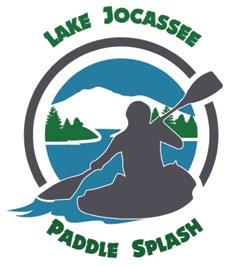
Upstate Native Nursery, Greenville, SC Order online at scnps.org before pickup.
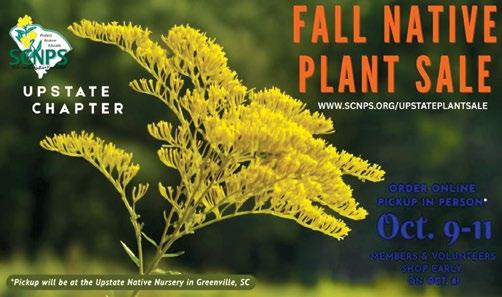
OCT. 13
Friends of Jocassee Native Plant Day
Devil’s Fork State Park Register at friendsofjocassee.org. Help clean the park of invasive plants.
OCT. 25
Fall Festival
Keowee Marina, 12:00 pm – 3:00 pm.
OCT. 28
FOLKS Annual Banquet

Keowee Key 5:30 pm – 8:00 pm Register at keoweefolks.org. The keynote speaker will be Mac Stone, the Executive Director of Naturaland Trust, a non-profit based in Greenville with a 50-year-history of protecting special places in South Carolina’s mountains and piedmont. For more than a decade Mac has led Naturaland Trust and helped protect tens of thousands of acres of iconic rivers, waterfalls, tributaries, and forests all of which are open to the public. An internationally acclaimed photographer for National Geographic Magazine, he uses compelling imagery and stories to help connect people to landscapes and conservation across the globe and to raise funding for milestone projects. To learn more about Naturaland Trust, visit naturalandtrust.org.
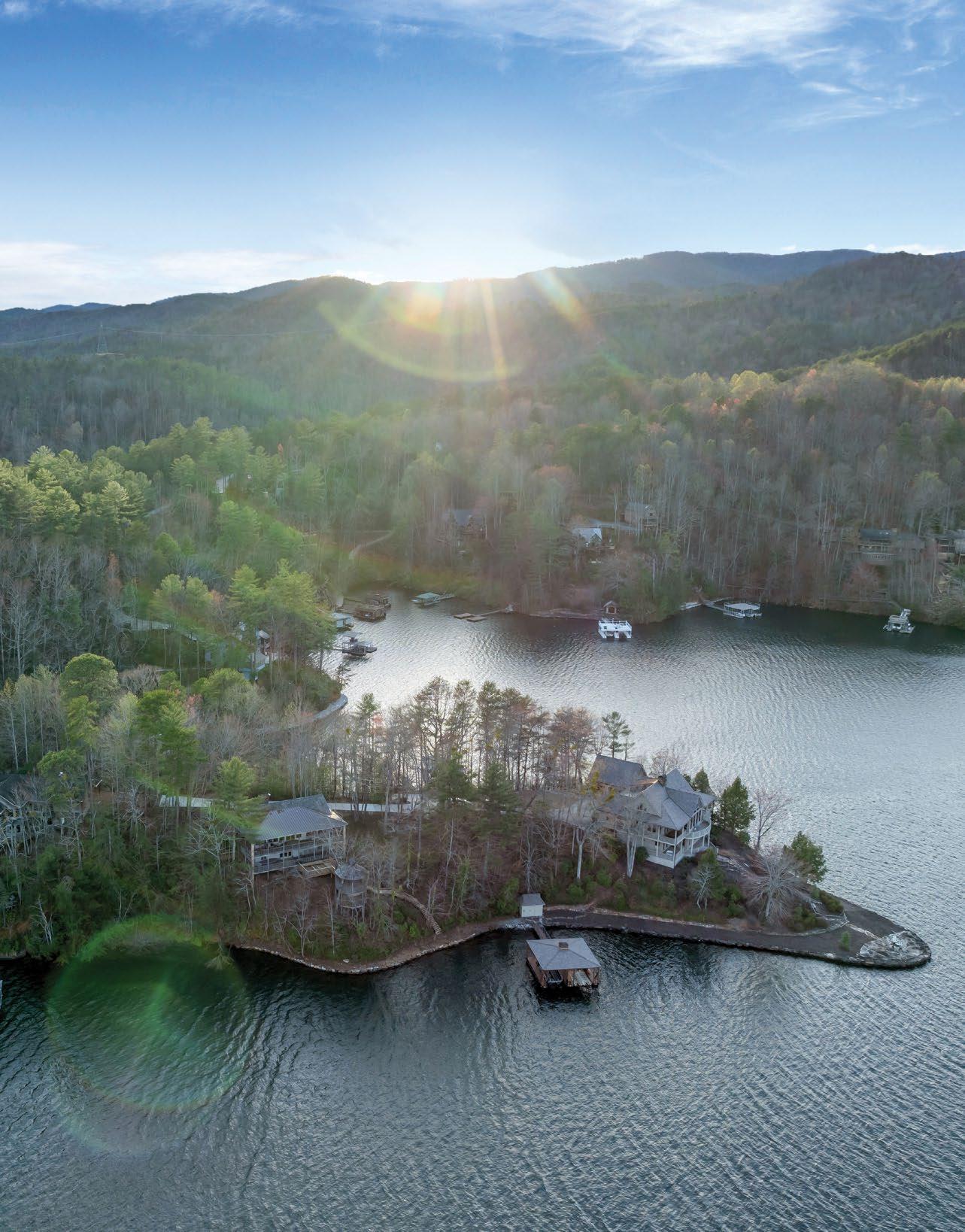

BY MELISSA HIGGS, Community Engagement Director, FOLKS
Rep. Patrick Haddon, a farmer and legislator from Greenville, SC, along with 16 other legislators, sponsored a bill during the 2023-2024 legislative session to amend the composition of the South Carolina Conservation Bank Board to include the Commissioner of Agriculture, the Secretary of Commerce, and the Secretary of Transportation, as well as to establish the Working Farmland Protection Fund. In a Greenville Online interview, he stated:
“Since the early 2000s, we’ve lost nearly 300,000 acres of farmland…I’m not against development. I’m not against housing complexes, I just think we need to be smarter about where we put them, especially when we start looking at developments out in the middle of rural communities.”
Subsequently, in April 2024, the Working Agricultural Lands Preservation Act (the “Act”) was signed into law by Governor McMaster. The Working Farmland Protection Fund (the “Fund”), created by the Act will help farmers preserve their lands through voluntary conservation easements. The South Carolina Agricultural Landowner’s Guide” defines the concept:
An agricultural conservation easement is a voluntary deed restriction that landowners willingly place on their land. It permanently limits subdivision and non-agricultural development. Landowners retain ownership of the property and can continue to farm however they choose. Public access is not required, and the land can be sold or passed along to heirs. However, future owners must abide by the terms of the easement. This ensures that the land always will be available for agricultural use (American Farmland Trust).
The Fund will provide matching grant payments for projects that meet certain
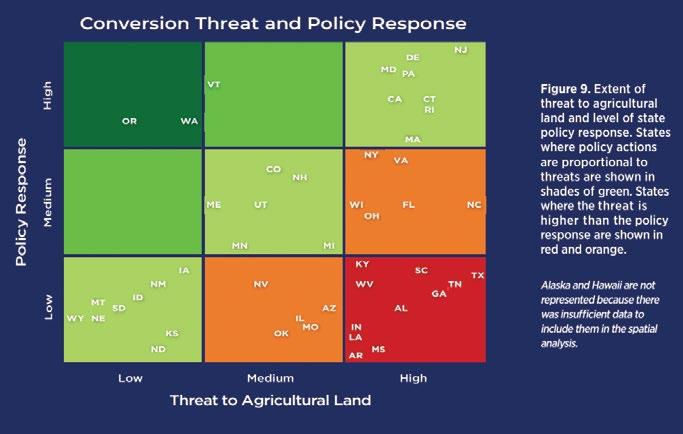
criteria. According to the Governor’s website: “Grant applications must meet specific evaluation criteria including, but not limited to, the value of the land’s natural resources, the economic viability of the property in terms of current and future commercial agricultural activities, and the threat of non-agriculture-related development. In addition, the landowner must derive at least 50% of their income from the eligible farmland.”
An article in the South Carolina Daily Gazette notes, “South Carolina lost more than 280,000 acres of farmland between 2001 and 2016, according to a study* by the American Farmland Trust. The Palmetto State was the eighth most at-risk of losing its farmland” (Laird, 2024).
Agriculture Commissioner Hugh Weathers also noted in the same article that retaining farms ensures South Carolina dollars stay in the state. “Agricultural products generated more than $17.3 billion in 2022, according to a Department of Agriculture study” (Laird, 2024).
This well-supported Act will help continue the agricultural legacy that is a significant part of South Carolina and provide food in food insecure areas of the state.
As the Oconee County Conservation Bank is reorganized for different purposes, we plan to present a series of articles about conservation easements. We have also invited Mac Stone, Executive Director of Naturaland Trust, to speak at our Annual Banquet at the end of October.
T he following resources provide more guidance for farmers interested in protecting their lands:
• The “American Farmland Trust’s Farms Under Threat: State of the States” and “South Carolina Agricultural Landowner’s Guide,” as well as many other resources, are available at farmlandinfo.org.
• Landowners often work with land trusts to protect farmland. The Land Trust Alliance (landtrustalliance.org/land-trusts/ gaining-ground/south-carolina) and The South Carolina Land Trust Network (scltn.org) provide information about these programs.
* Study can be found here: https://farmlandinfo. org/wp-content/uploads/sites/2/2020/09/AFT_ FUT_StateoftheStates_rev.pdf

BY JACKSON HIGGS, Jack Lewis Watershed Scholarship Recipient and Griffith Scholar, Presbyterian College Student
The waters of Lake Keowee converge with two other lakes in the area, Lake Jocassee and Lake Hartwell. But did you know that the water in Lake Keowee also flows into other lakes on the South Carolina-Georgia border?
My mom and I have been visiting South Carolina’s State Parks as part of the Ultimate Outsider Challenge. To complete the challenge, visit a SC State Park to get your Ultimate Outsider booklet, containing information about all the state parks, and use the stamp available at each park to validate your visit. Attempting to become an Ultimate Outsider is a great way to spend time in nature, while learning about the ecology and history of the state. As part of our adventure to become Ultimate Outsiders, my mom
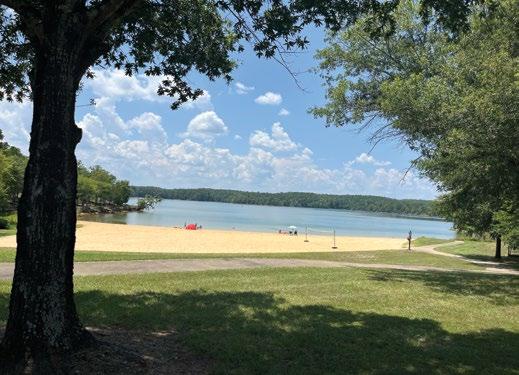
and I recently visited multiple state parks located in the Savannah River Basin, the watershed that begins at Lake Hartwell and flows into the Savannah River. The same water that is in Lake Keowee also moves through this basin.
Our first stop on the trip was Calhoun Falls State Park in Abbeville County. We had already visited Sadlers Creek and Lake Hartwell State Parks, which border Lake Hartwell, so we bypassed them for this trip. Calhoun Falls State Park is the only state park in South Carolina on Lake Russell, a lightly developed reservoir connected to Hartwell by an Army Corps of Engineers dam. The lake’s purpose is

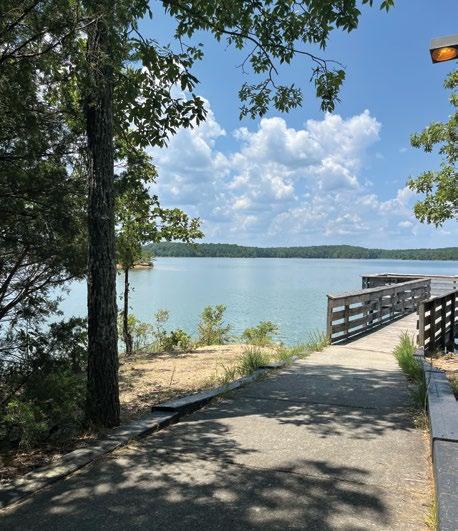
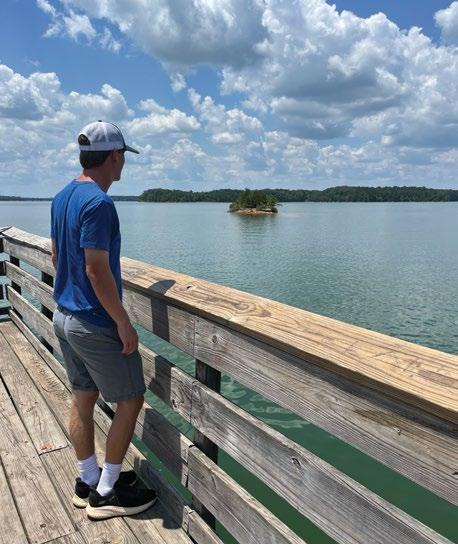

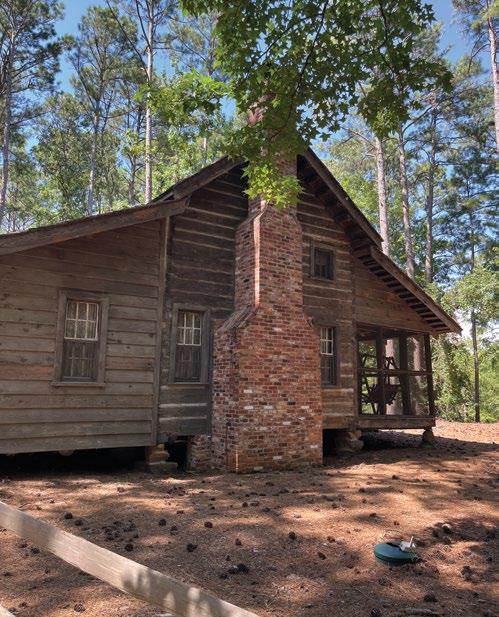
to generate hydropower through the Russell Power Plant, provide flood control, supply drinking water for Abbeville and Elberton (GA) counties, and promote fishing and recreational activities. Calhoun Falls State Park provides lake access for boating, fishing, and swimming, all of which encourage people to visit this important body of water. Additionally, Calhoun Falls offers many campsites with lake views, easy nature trails, and equestrian trails at nearby McCalla State Natural Area (sctrails.net/trails/trail/mccalla-statenatural-area). If you want to understand more about the reservoirs
that play a vital role in the state’s drinking water and energy supplies, visit Calhoun Falls State Park.
The next stop was Hickory Knob State Resort Park in McCormick County. Hickory Knob is known for its unique amenities, including a skeet and archery range, axe throwing, a swimming pool, championship golf course (complete with a pro shop), and motel. From the golf course, there are clear views of J. Strom Thurmond Lake, another lake in the Savannah River Basin. Lakes Russell and (continued on page 12)
(continued from page 11)
J. Strom Thurmond are divided by a dam that contains pumpback units which enable water from J. Strom Thurmond to reenter Lake Russell at night to be reused during peak hours to generate electricity. Along with the important features that make J. Strom Thurmond Lake vital for energy production, it is the largest Army Corps of Engineers lake east of the Mississippi River, with an excellent environment for striper and bass fishing (Recreation. gov). Hickory Knob State Resort Park has a fishing pier, boat ramp, and kayak/canoe dock where anglers can easily access the lake. If you would prefer to camp under the stars at Hickory Knob, campsites with lake access are also available. Hickory Knob and the surrounding areas are also packed with history. French Protestant immigrants known as Huguenots settled in the region during the mid-1700s, creating the town of New Bordeaux. Remnants of their settlement remain in McCormick County, including in Hickory Knob State Park, where they moved a historic Huguenot home that was built in the 1700s. From golf, to fishing, to historical homes, Hickory Knob has something for everybody.
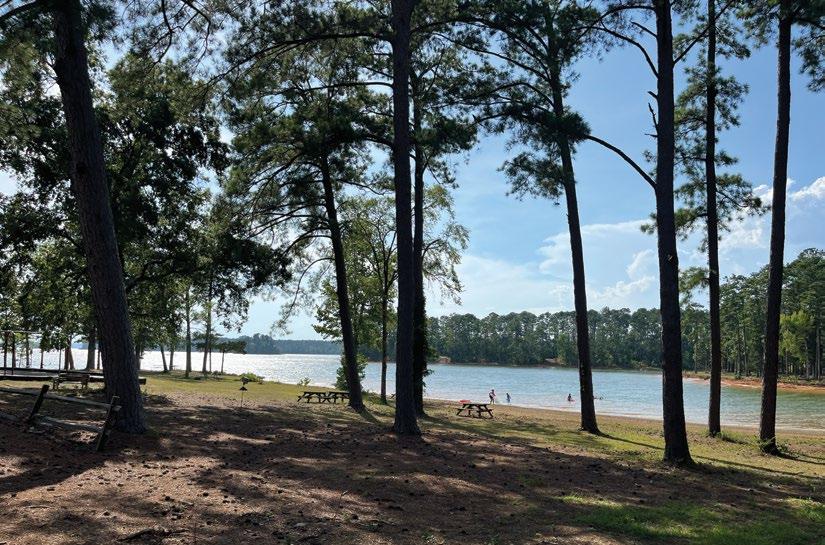
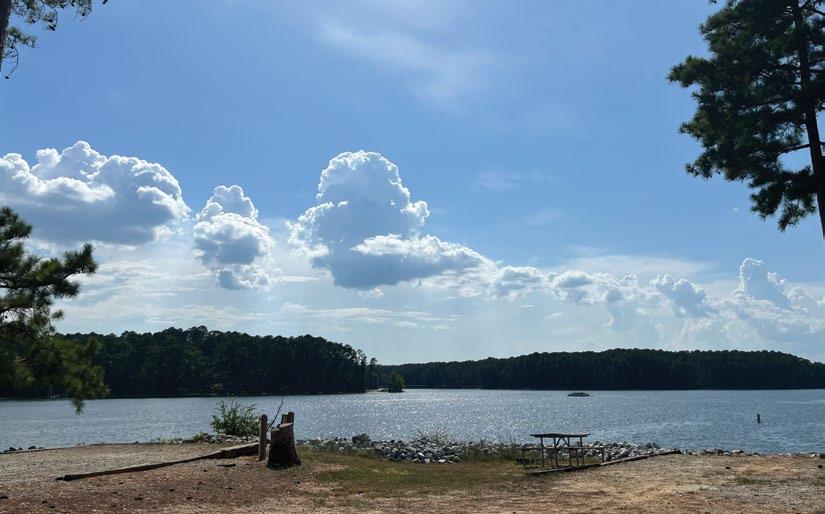
After visiting Hickory Knob, my mom and I travelled to two other parks in McCormick County, Hamilton Branch State Park, and Baker Creek State Park. They are also conveniently located on J. Strom Thurmond Lake, so fishermen seeking to catch bass, crappie, catfish, bream, and striper can fish there (southcarolinaparks.com/baker-creek). Additionally, there are trails for both bikers and hikers. Hamilton Branch’s short bike trail connects to the 12-mile Stevens Creek Bike Trail. Visitors to Baker Creek can also enjoy a relaxing meal at one of the picnic
areas beside the lake or watch the sunset from the park’s pavilion, which is large enough for a group outing. If you are interested in exploring the natural coves of J. Strom Thurmond Lake further, Baker Creek flows into the lake nearby and provides habitat for a variety of wildlife. Hamilton Branch offers a unique self-serve kiosk for renting kayaks. They also have 150 lakefront camping sites (114 currently available due to cleanup efforts).
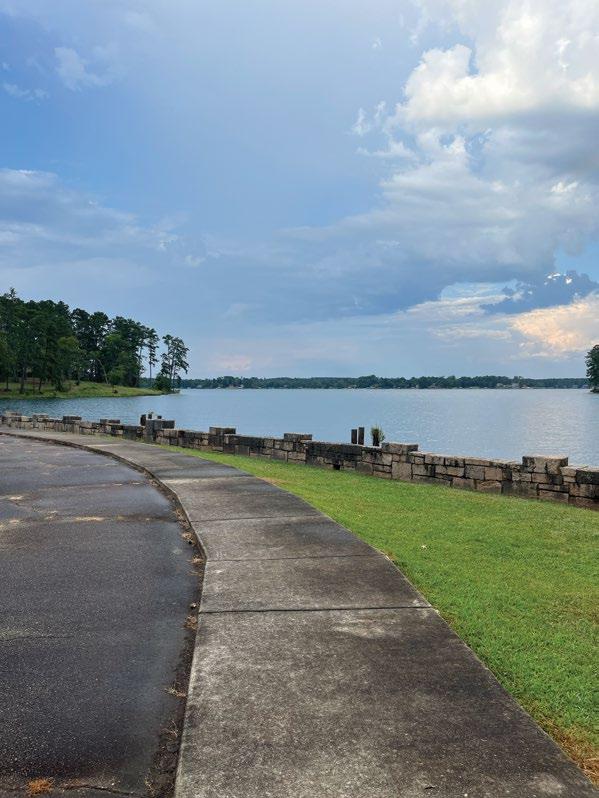
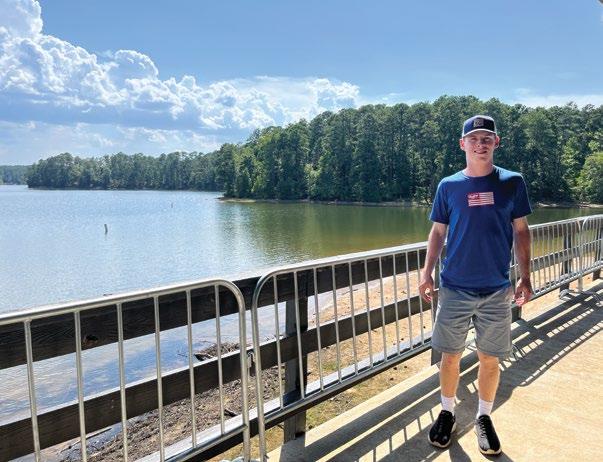
While in the area, take a short trip to the nearby towns of McCormick, Willington, and Mount Carmel. McCormick is home to the McCormick Arts Council at the Keturah (MACK), a non-profit organization that provides art, culture, and education to the region through exhibits, programs, and performances in the Historic Keturah Hotel, part of the National Register of Historic Places. Located north of McCormick, the hamlet of Willington features the History Center and Bookshop that highlights the cultural and historical significance of Willington. The Willington Bookshop contains over 40,000 new and used books on a variety of topics, while the Willington History Center and African American Center both showcase the legacy of Huguenot, Scot Irish, and African American residents of the area. If you are hungry after visiting these locations, visit the Mount Carmel Café in the village of Mount Carmel, a lunch spot that serves classic American home cooking.
To cap off our trip, we stopped by Lake Greenwood State Park. Located on the shores of Lake Greenwood, this state park offers a variety of activities for outdoorsmen and history enthusiasts. Although Lake Greenwood is not connected to Lake Keowee through the Savannah River Basin, it is still worth mentioning, due to its role as a drinking water source and important freshwater ecosystem, part of the Saluda River Watershed, which eventually flows to Charleston. The lake was formed when a dam was built at the convergence of the Saluda and Reedy Rivers during the 1930s (upstateforever.org/saving-lake-greenwood). At the same time, Lake Greenwood State Park was being constructed by the Civilian Conservation Corps (the “CCC”), a work relief program for young men during the Great Depression. When the US entered World War ll, the CCC was dissolved, leaving an unfinished rock wall at Lake Greenwood State Park. Visitors can still see this rock wall, along with a view of Lake Greenwood from a walking path near the park entrance. In addition, you can explore the Civilian Conservation Corp Museum located in the Drummond Center, fish from the rock wall or pier, try to find one of the park’s geocaches, or view wildflowers and wisteria during March and April (southcarolinaparks.com/lake-greenwood).
Lake Keowee is definitely one of the best lakes in the Southeast and is also part of a larger watershed. Pollution and environmental degradation that occur in Lake Keowee can have a significant impact on communities and ecosystems downstream. Reservoirs like Lake Russell are a significant source of drinking water for our neighbors in Anderson, Abbeville, and Elbert (GA) counties. Lakes Russell and J. Strom Thurmond are also well stocked with fish that individuals catch and consume as part of their diets. If you are interested in preserving Lake Keowee and the Savannah River Basin as a whole, it is important to support the advocacy, education, and conservation initiatives of FOLKS. Teaching people about the necessity of lake management will help preserve our watershed for years to come.
BY MELISSA HIGGS, Community Engagement Director, FOLKS
At the last FOLKS Speaker Series event of 2025, Sheriff Crenshaw shared the vision, mission and core values of the Sheriff’s Office. The Sheriff first pointed out the right and duty of the Sheriff’s Office to exercise the public trust and to have some sovereignty in order to execute and administer the law. Therefore, he views them as an “office,” not a “department,” which would be a division of the executive branch. In addition to law enforcement, the Office is responsible for a 200-240 bed detention facility, Animal Control, and 911 Emergency Communications. The 2025-26 budget for law enforcement in Oconee County is $22,091,688, an increase of approximately $1,600,000 from the previous year. Oconee County has experienced tremendous growth, yet the officers have stayed focused on seven core values: courage, fairness, respect, compassion, integrity, honor, and inclusion.
Over the past 20 years, violent and property crimes have decreased in Oconee County, while scams and frauds have experienced an upward trend. The Sheriff’s Office made 3,904 traffic stops in 2024, and there were 47 vehicle pursuits. Oconee County is the first in the world to have an app to warn drivers of a pursuit nearby. Digital Siren can be downloaded in your app store.
The Sheriff’s Office continues to address needs in the community, such as acquiring a K9 to detect vapes in schools, applying for a grant for the homeless, and administering new laws, such as those against drug induced homicides and organized retail crime. The Office has also worked to incentivize being an officer with better pay increases for promotions and education achievements. To reduce recidivism, they have college


certification and Life after Lockup programs for incarcerated individuals. For middle school students they are implementing the L.E.A.D. curriculum to promote leadership, and they are reaching out to neighborhoods with community meals and support. The Oconee Sheriff’s Office has met the extensive criteria for South Carolina Accreditation, a testament to their dedicated efforts.
FOLKS is particularly thankful for the Office’s partnerships with the SC Department of Natural Resources, as they now have a boat, they use on area lakes and a shared radio channel for communication. Also, neighboring counties have the capacity to provide helicopter air lifts and other assistance if needed. The Office has a Parks Recreation and Tourism Deputy who is paid through ATAX tourism funds to provide foot patrol for county-owned or managed parks and recreation areas. In addition, they provide heavy patrol of congested landings, which has decreased the amount of trash Lake Sweep groups need to clean up. The Marine Unit makes 4,000+ contacts annually and issues 100+ citations.

A Citizens Police Academy is available if you would like to learn more about Oconee County Sheriff’s Office programs. Contact the Sheriff’s Office for more details. They appreciate your support.

BY SUE WATTS, Educational Program Coordinator SC Botanical Garden
Without nature’s clean-up crew, our world would be in big trouble! Imagine piles of dead trees, crunchy leaves, and dead animals that never went away. Luckily, some amazing helpers keep our planet clean and healthy. Fungi (mushrooms), rolypolies and vultures are just a few of the hard workers who make sure we don’t drown in nature’s leftovers. You can learn all about them at the South Carolina Botanical Garden’s Nature Center
Open House on Saturday, October 25 from 1 to 4 p.m. Come join us for free, fun, family-friendly activities!
We see mushrooms above ground, but most of the fungus lives underground. Tiny threads called hyphae stretch through soil and old plants, breaking them down into food. As fungi recycle wood and leaves, they also give back nutrients like nitrogen and carbon—helping plants grow strong and green. Without fungi, our soil would be empty and lifeless!
Have you ever picked up a little roly-poly and watched it
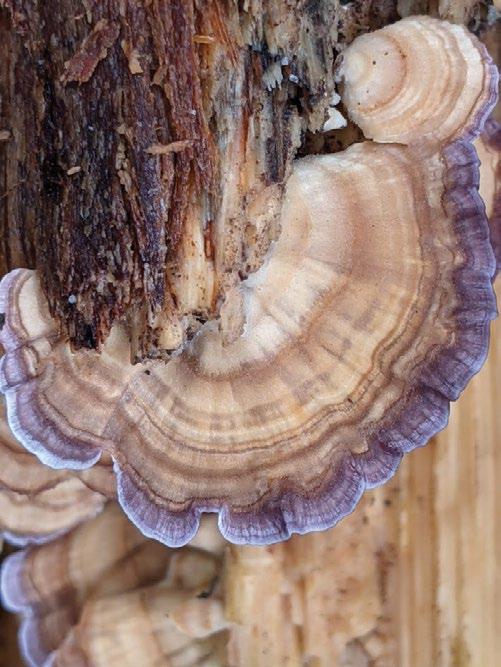
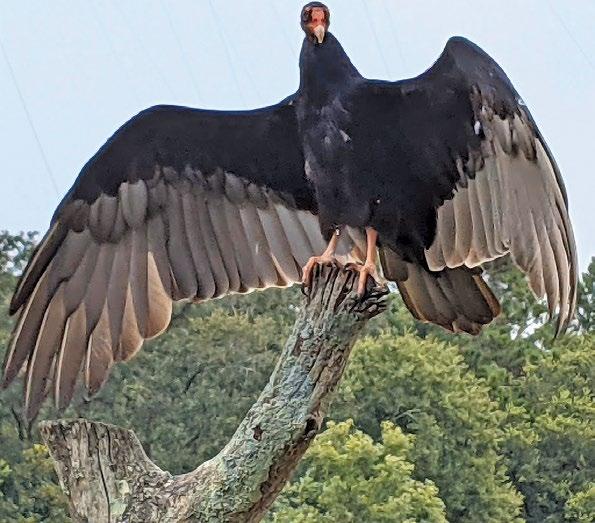

PHOTO IDENTIFIER: 1 - Violet-toothed Polypore (Trichaptum biforme) 2 - Vulture 3 - False Turkey Tail 4 - Bay Bolete or King Bolete 5 - Mushrooms found in the SC Botanical Garden (I.D. provisional) 6 - Isopod
curl into a ball? These tiny critters live almost everywhere on Earth (except Antarctica!). Roly-polies are nature’s “chewers.” They munch on dead plants and turn them into smaller pieces, releasing nutrients which also helps enrich the soil. The next time you spot one, remember—they’re working hard to make gardens and forests healthy.
High up in the sky, vultures soar on rising warm air. These are

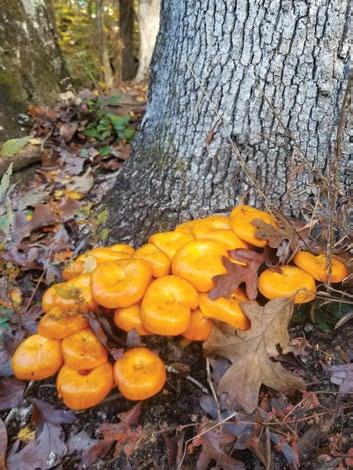
nature’s recycling birds! Vultures find and eat animals that have died, cleaning up what’s left behind. In just a few days, a whole carcass can disappear, leaving only bones. It may sound gross, but vultures are heroes; they keep our world safe from disease.
Nature’s clean-up crew may not be the cutest or cuddliest, but

they are some of the most important helpers on Earth. From fungi that feed the soil, to roly-polies that grind up plants, to vultures that recycle animals, each one plays a special role. Come meet these fascinating workers at our Open House, and discover how they keep the world clean, green, and full of life!

BY JOHN HAINS, Clemson University (Retired), Clemson Public Service and Agriculture (PSA), and FOLKS Board Member
Years ago, my boss asked me to smell his tap water in Clemson, SC. It had a delicate bouquet of geosmin and MIB (2-Methylisoborneol), two chemicals that cause taste and odor problems in water and some foods. I informed him that the aroma was due to cyanobacteria in the source water (Lake Hartwell) but aside from the odor, it was safe to drink. I still chuckle at the memory of his facial expression. In one of the news sources recently, I read yet another article about the extensive ongoing algal bloom in Lake Hartwell. “Tis the season!” On the other hand, “the times, they are a-changing.”
Normally, I don’t expect much spring activity in my work area at the Plant and Pest Diagnostic Clinic (part of Clemson University’s Public Service and Agriculture program). However, this spring has been full of surprises, including the unexpectedly early cyanobacteria bloom on Lake Hartwell and elsewhere. First, some background on just how the cyanobacteria (a.k.a. blue-green algae) fit into the microbial world and
more importantly, in our lakes.
Cyanobacteria are microscopic unicellular organisms that are prokaryotic and have a large number of interesting and sometimes alarming capabilities. Prokaryotic organisms are those which include all bacteria and do not have a true membrane-bound nucleus for genetic material. They also don’t have membranebound organelles, such as mitochondria and chloroplasts.



In contrast, eukaryotic organisms do have true membrane-bound nuclei as well as membrane-bound organelles. Humans and all plants, fungi, animals, and even multicellular (and some unicellular) microscopic organisms are eukaryotes. Sometimes we eukaryotes arrogantly refer to prokaryotes as “primitive.” Their simplicity masks an elegance that has been finely-honed through billions of years of evolution.
The consensus is that about 3.5 billion years ago, life on earth began. The best evidence is that the first organisms were prokaryotic and the first photosynthetic ones might have been very similar to today’s cyanobacteria. These organisms have survived every attack, every assault that the entire planet could “throw” at them for about 3.5 billion years. Believe me; they are prepared for us. Still feeling arrogant?
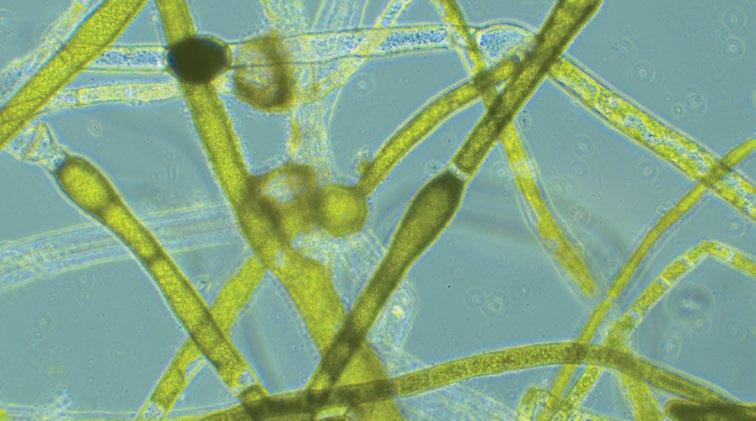
Technically, blue-green “algae” are bacteria, specifically cyanobacteria, and are separate from eukaryotic algae. However, in vernacular terms we tend to lump cyanobacteria with the others and refer to all of them as “algae” while trying to keep in mind the important differences between them.
Cyanobacteria cells can: fix nitrogen from the air, store other nutrients for later use, enter “resting” stages for indefinite periods, modify their buoyancy thus adjusting their depth in the lake, multiply rapidly asexually when conditions allow, live for extended periods without oxygen, and undergo photosynthesis. They develop unique pigments adapting to high or low light intensity, using wavelengths of light that other photosynthetic organisms can’t use, to survive extreme heat, extreme cold, and desiccation. Under circumstances we still don’t fully understand, they create a suite of compounds that tastes or smells bad or even toxins that can sicken or kill. A single cyanobacteria cell can do all of this without the aid of internal membrane-bound structures. “Simple elegance” just doesn’t quite describe it.
When any algal species grows in quantities that we view as harmful, then that “bloom” is called a “harmful algal bloom” or HAB (Figure 1). So, what are the most common algae that form HABs? Figure 2 shows two genera of cyanobacteria that are known to form HABs. The Dolichospermum (a.k.a. Anabaena) was found in the Lake Hartwell bloom. In Figure 2 it is curly. Microcystis is the best known of all and has been found in
numerous locations around SC. In Figure 2 the Microcystis looks like several masses of tiny dots. In the early 1970s, Microcystis bloomed in areas of Lake Keowee near Seneca and in a cove at Cane Creek. Both, as well as most other common cyanobacteria, are capable of producing toxins. However, we sometimes find extensive blooms of filamentous algae like Pithophora or Cladophora (Figure 3), both of which are eukaryotic “green” algae, neither of which produce toxins. A bloom of Pithophora clogged large areas of Lake Greenwood years ago and local residents certainly viewed it as a HAB. The concept of “harmful” is sometimes a subjective judgment.
In the past, I wouldn’t have expected a “bloom” to occur in this region until mid-to-late summer, but summer seems to be arriving earlier and earlier. These past few years, and this year in particular, my microscope and I have been unexpectedly busy.
You may be wondering: Do these exist in Lake Keowee? Has there ever been a large “bloom”? Could it happen again? (Yes) Will it happen again? (Probably, some day)
How can we prevent it? Our understanding of what causes these “blooms” is incomplete. We do know the following are important to algae:
• Nutrient enrichment
• Water temperature
• Water motion
However, predicting a bloom, what organism, time of year, duration, and toxicity is nearly impossible. As one of my favorite statistics professors used to note, “Rare events occur with a probability of 1 [a sure event].” What is in store for Lake Keowee? There are a few clues but there are plenty of unanswered questions!
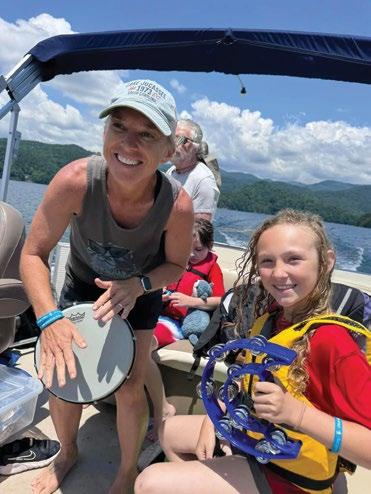
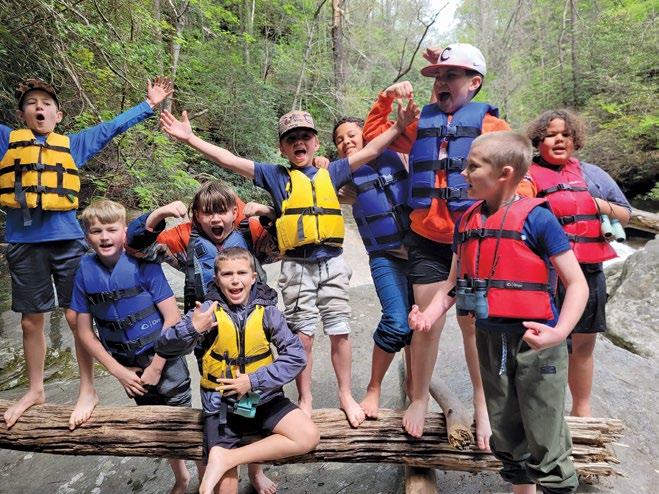
BY JAY BROWDER, Jocassee Wild Outdoor Education, Inc., Board of Directors
Picture a group of third graders from a rural Title I school peering through binoculars as their pontoon boat approaches an 80-foot waterfall. Their excited cheers echo across the crystalclear waters as they experience Lake Jocassee and the Jocassee Gorges for the very first time—despite living just miles from one of National Geographic’s “50 World’s Last Great Places: Destinations of a Lifetime.”
This scene unfolds regularly thanks to Jocassee Wild Child, a program under Jocassee Wild Outdoor Education, Inc., a local 501(c)(3) non-profit. Founded in 2020, Jocassee Wild Child has transformed how youth engage with science, nature, and themselves.
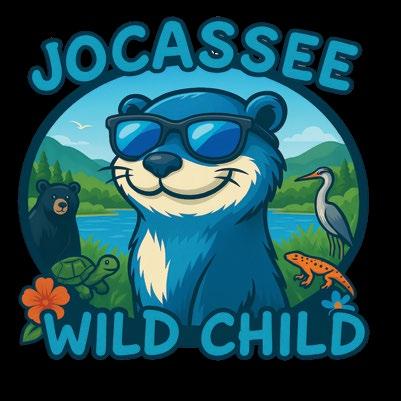
For those of us fortunate to call the Jocassee area home, the lake’s pristine beauty and remarkable biodiversity are familiar treasures, but for many local children from low-income families, this natural wonderland remains largely unknown and
inaccessible. Jocassee Wild Child bridges that gap by operating floating classrooms that turn our 7,500 acres of lake and 43,000 acres of protected forestland into an immersive learning environment.
Program Director Kerry McKenzie leads a team of certified naturalists and volunteers who guide students on four-hour educational adventures. While on their adventure, each child receives access to a backpack with binoculars, compass, and grade-appropriate materials, while every pontoon boat serves as a mobile laboratory complete with microscopes, nets, and educational resources covering geology, ecology, climate science, and local Cherokee history.
Since its founding, Jocassee Wild Child has served nearly 2,500 students from Title I schools in Anderson, Oconee, and Pickens counties. Just this past spring, over 1,000 students participated, with 255 students requiring full financial assistance, children who would never have experienced the Jocassee Georges eco-region without donor support.
“This knowledge can encourage a new generation to preserve
(continued on page 22)

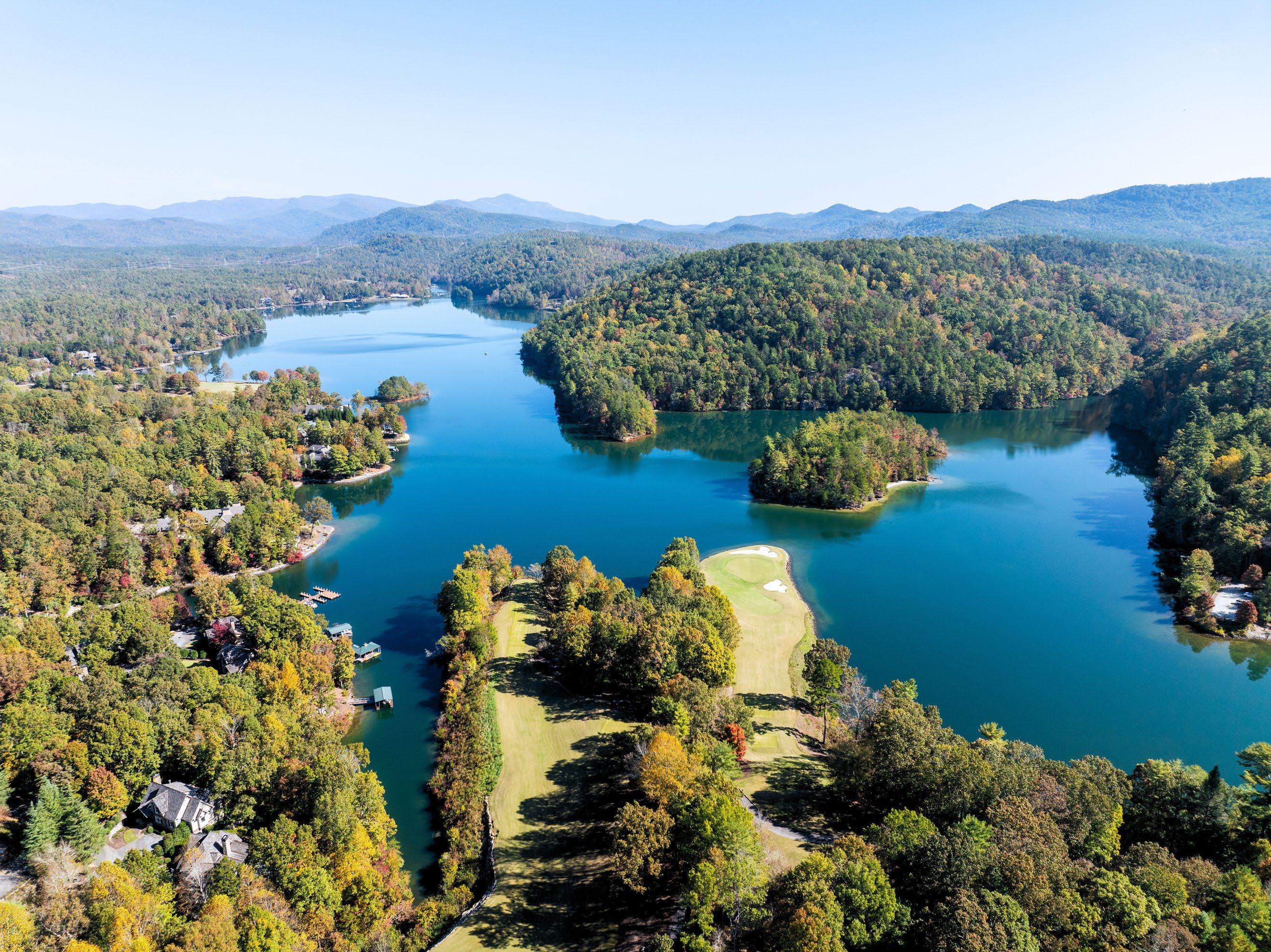
P r o s p e c t i v e b u y e r s o f t e n a s k o u r
t e a m “ w h a t ’ s t h e a r e a ’ s g r e a t e s t
a t t r a c t i o n — t h e c o m m u n i t i e s , t h e
g o l f c o u r s e s , t h e c l u b s ? ” “ L a k e K e o w e e ” i s o u r r e s p o n s e .
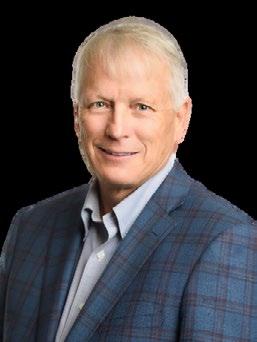


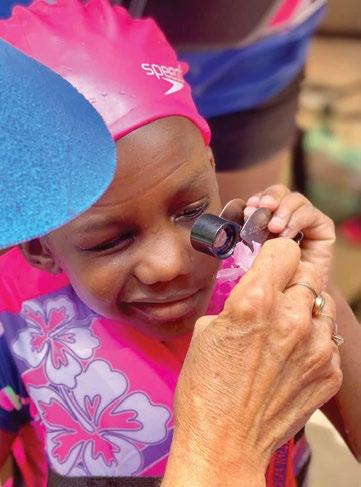
and protect this place we all love, and for many of these kids this is the adventure of a lifetime,” explains McKenzie. The program addresses critical gaps in rural education where limited budgets prevent schools from offering outdoor learning experiences.
The curriculum meets South Carolina state science standards while fostering social-emotional development, confidence, and environmental stewardship. Students discover the exceedingly rare Oconee Bell wildflower, explore geological forces that shaped our mountains, and learn how the Eastern Continental Divide creates our unique temperate rainforest ecosystem—all while building lifelong connections to the natural world.
What sets Jocassee Wild Child apart is its understanding that outdoor education serves broader developmental needs. Research consistently shows these programs support behavioral and intellectual growth while developing creativity and problem-solving skills in ways
The program’s blue otter mascot, Odyssey, joins every adventure as more than just entertainment—he’s a role model embodying the mission of making personal, ecological, and social connections with wild spaces. Students return to their classrooms energized and engaged, often referencing their Wild Child experience in subsequent lessons throughout the year.
Regional partnerships with the Upstate Master Naturalist Association, Foothills Trail Conservancy, Friends of Jocassee, Friends of Lake Keowee Society, and Cliffs Residential Outreach allow the program to incorporate expert knowledge with guest speakers and provide additional funding for additional educational resources.

As screens increasingly dominate children’s attention, outdoor education programs like Jocassee Wild Child become even more crucial for healthy development. The organization works to expand its reach while maintaining the highquality, personalized experience that makes it effective—developing educational resources for families and schools while training more
certified naturalist guides and community volunteers.
Current funding challenges mean many students from underserved communities can only participate through grants and donations. Without this support, children living in the shadow of our mountain-lake paradise would never experience its wonder firsthand.
Every $65 sponsors one child’s adventure on Lake Jocassee. Every $600 sponsors an entire boat of children. Larger gifts can sponsor whole classrooms or help develop educational resources benefiting hundreds of students annually.
When you support Jocassee Wild Child, you’re investing in the next generation of environmental stewards who will protect and preserve natural treasures such as the Jocassee Georges. You’re ensuring that economic circumstances don’t prevent local children from discovering the wonder that exists in their own backyard.
• Direct donations: Visit www.jocasseewild.org to make a secure online donation.
• Mail donations: Send checks to Jocassee Wild Outdoor Education, PO Box 582, Salem, SC 29676
As Thomas Berry observed, “Teaching children about the natural world should be treated as one of the most important events of their lives.” In the pristine waters of Lake Jocassee and the lush forests and dramatic waterfalls of Jocassee Gorges, guided by passionate naturalists, that’s exactly what’s happening—one child, one pontoon boat, one magical day at a time.
To learn more, or to donate, visit JocasseeWild.org or email Kerry McKenzie at kerry@jocasseewild.org. Follow their adventures on Facebook and Instagram, search @JocasseeWild. Visit Jocassee Wild Outdoor Education on YouTube for a video about the experience.
Help ensure every child has the chance to discover the wonder of our Jocassee Gorges. Sometimes, the most important classroom has no walls—just endless sky, crystal-clear water, and the timeless magic of the natural world we’re privileged to call home.
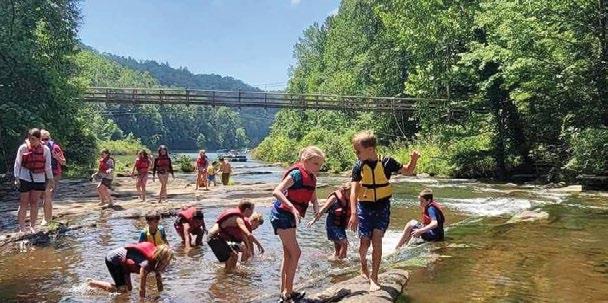




BY LIZ JOHNSON, Superintendent, High Falls County Park
High Falls County Park’s Sparkleberry Nature Trail is now part of the national TRACK Trails network, thanks to a partnership between Oconee County Parks, Recreation & Tourism (PRT), the Healthy Oconee Coalition, and Kids in Parks. A ribbon cutting ceremony on August 1st marked the official opening, followed by a guided hike led by Ranger Liz and Ranger Jon.
Kids in Parks is a free, nationwide program that connects families to the outdoors through self-guided adventures. The program offers printed TRACK Trail activity brochures and smartphone e-Adventures that turn any hike into a hands-on exploration. Kids can log their completed adventures online to earn prizes, encouraging repeat visits and deeper engagement with the outdoors. The Healthy Oconee Coalition, a group made up of many different organizations dedicated to increasing the quality of life of Oconee County citizens, secured grant funding to provide TRACK Trail signage for Sparkleberry Nature Trail. With this addition, all three Oconee County parks now feature a TRACK Trail, bringing the county total to six. The new trail offers families an accessible, engaging way to discover the natural beauty of Lake Keowee’s shoreline.
During the ribbon cutting event, community members explored activity stations along the trail, including identifying animal tracks, examining mammal furs, and creating tree bark and leaf rubbings. These stations reflected the type of nature-based experiences the trail is designed to encourage—moments where children slow down, look closely, and discover something new.

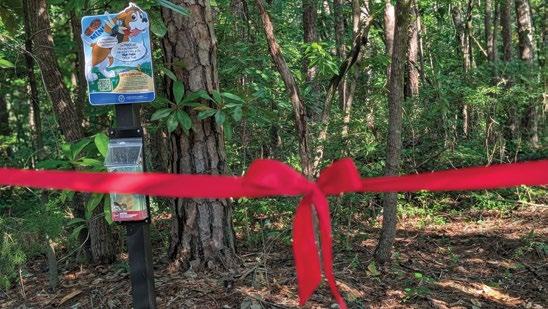
In the coming months, additional interpretive signage will be installed along the Sparkleberry Nature Trail. These signs will encourage kids to engage all their senses--listening for bird calls, searching for insect habitats, and comparing different tree species while learning about the interconnected web of plants, animals, and habitats that make up the Lake Keowee ecosystem. This type of handson learning fosters a sense of stewardship in young visitors, helping them understand that the health of local wildlife depends on healthy habitats.
By inspiring curiosity and creating positive outdoor experiences for children and families, the Sparkleberry Nature
Trail plays a role in long-term conservation efforts. When kids learn about and connect with nature at an early age, they are more likely to value and protect it as adults. Programs like TRACK Trails provide the tools for these connections to happen, making environmental education both fun and memorable. For more information about TRACK Trails and to begin your own adventure, visit kidsinparks.com, and for more Oconee County Parks and Recreation programs, visit ExperienceOconee.com/calendar.




BY KATE CLEVER, Scholarship Liaison, FOLKS and AMANDA GLADYS, Science Department Chair, Walhalla High School
Friends of Lake Keowee Society (FOLKS) is proud to announce the 2025 -2026 scholarship for high school students who show a strong interest in natural resource conservation and the environment. Our scholarship is named in honor of Jack Lewis, whose time with FOLKS spanned more than 20 years, and whose enthusiastic attitude, keen sense of duty, and good heart were evident throughout his tenure.
FOLKS strives to turn passion for conservation into action and encourages students to work for the issues they believe in. We believe that every act of environmental stewardship—no matter how small—helps the world become a better place. Our scholarship will engage students in their community and inspire
(continued on page 32)
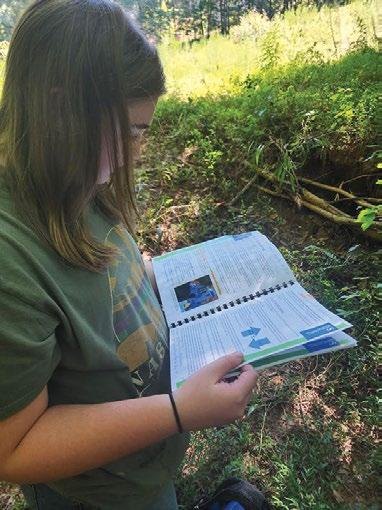
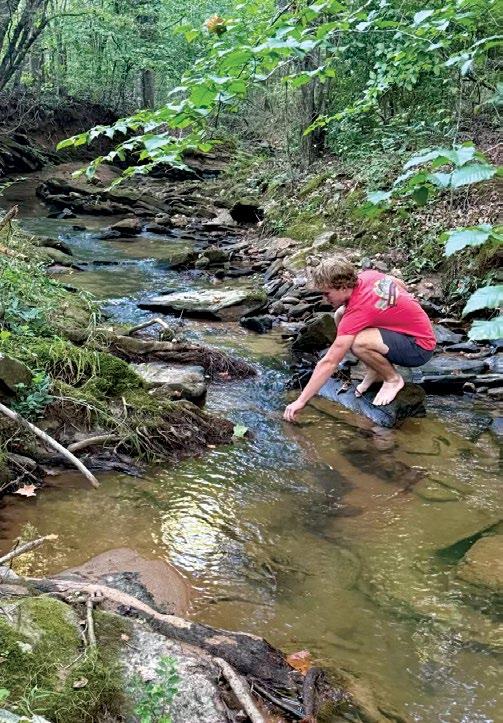
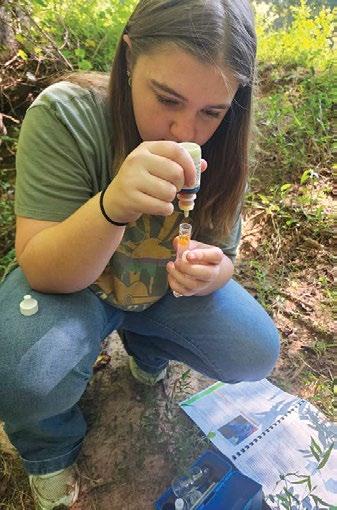
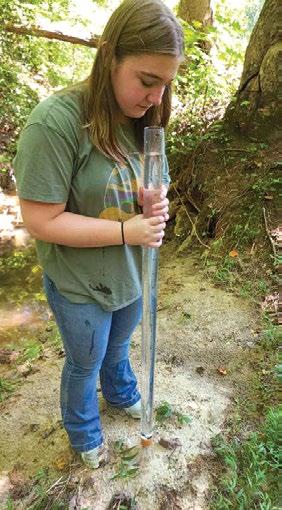






Our scholarship will engage students in their community and inspire them to be advocates for the environment, whether local or global.
them to be advocates for the environment, whether local or global. FOLKS awarded scholarships to three students in 2025, all of whom are actively monitoring their streams.
FOLKS would like to recognize and thank The Cliffs at Keowee Falls Cliffs Resident Outreach (CRO) and Melanie Fink and Associates for their 2025 scholarship endowments and continued support. The scholarship program is supported by the donations of organizations and individuals.
Scholarship applicants must be residents of either Oconee or Pickens County, full-time high school students in good academic standing, and classified as a sophomore or junior during the 2025–2026 school year. The applicant shall indicate his/her intent to apply to either a two-year or four-year college curriculum on the application. Upon notification of eligibility to participate in the scholarship program, students will be required to attend the SC Adopt-a-Stream Freshwater Monitoring workshop and obtain certification. Workshop classes are free, and the sampling materials/kits are provided at no cost.

Selected students will be required to monitor a designated stream segment for a period of six consecutive months, adhering to SC Adopt-a-Stream protocols, and to provide a presentation on the health of the stream throughout the sampling period. Prior to sampling, the student will conduct a Habitat Assessment using the form and methods described in the SC Adopt-a-Stream workshop. Students are expected to upload their data and results of the assessment to the SC Adopt-a-Stream database.
The FOLKS Scholarship Application is available at the FOLKS website: FOLKSkeowee.org/scholarship.
The application must be completed and all required materials submitted no later than November 22, 2025. Students who qualify for the scholarship will be announced in February 2026.
FOLKS would like to recognize and thank The Cliffs at Keowee Falls Cliffs Resident Outreach (CRO) and Melanie Fink and Associates for their 2025 scholarship endowments and continued support.












We appreciate the support of our Corporate and Business Members and know that they will appreciate your patronage. When you do so, please thank them for supporting FOLKS.
Blue Ridge Electric Cooperative, Inc.
City of Seneca
Duke Energy
Greenville Water
Greg Coutu — Allen Tate Realty
Keller Williams Seneca Keowee North — Patti & Gary Cason, Melissa Cason Custer, Corey Custer
Keowee Key Property Owners Assn.
Melanie Fink and Associates — Allen Tate Realty
Oconee Federal Savings & Loan
Stoneledge Home Owners Association
The Reserve at Lake Keowee
Action Services of Oconee, Inc
Advocates for Quality Development
Allen Tate — John Pulliam
Backwater Landing
Blue Ridge Bank
Carolina Bay Healing
Spring Waters
Carolina Wealth Management
Classic Lighting
Custom Dock Systems, Inc.
Dolly’s Roofing
Dorn’s Landscape Service
For the Birds, Inc.
Golden Corners Lakes
Sail & Power Squadron
Goldie & Associates
Justin Winter & Associates
Forbes Global Properties
Keowee North Marine
Kingfisher Maps
Kroeger Marine Construction
Lake Keowee Marina
Metal Lake Maps — Ken Van Natta
Northwestern Supply
Porch Conversion of Seneca
Rainmaker Ponds and Irrigation
Sexton Griffith Custom Builders, LLC
Shorescapes, Inc
Strickland Marine and RV
The Boat Dock Company
The Cliffs at Keowee HOA
The Happy Berry
The Lake Company — Lake Keowee
The Wine Emporium
T & M Custom Docks
Upstate Insurance Agency
Vassey Financial Planning and Investments
Waterford Pointe HOA
By Dale Wilde, FOLKS President
The FOLKS Board recently learned that Carl Dunn passed away in June of this year. Carl leaves behind his wife Jacqui of nearly 68 years, three adult children and seven grandchildren. Carl was a long-time FOLKS member and served on the FOLKS Board for six years. Carl was very active with Keowee-Toxaway habitat enhancement projects during his tenure, participated in Lake Sweeps, and many other projects undertaken by FOLKS. He and his family loved Lake Keowee, and they dedicated many long hours to the FOLKS mission of preserving this watershed. Carl will be missed by all that knew him. The FOLKS Board genuinely appreciates all that Carl did and for his support over the decades.
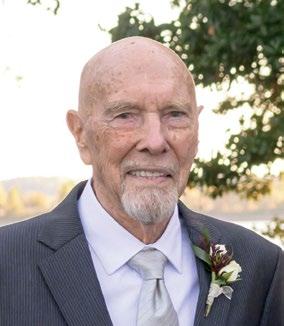
In Carl’s memory, below is an edited reprint of a short article about him written by Judy Koepnick in 2015.
Going back to the May 1994 Sentinel we came across the first article of a series introducing John Barnes, the first FOLKS President. We decided to restart the tradition and Carl Dunn volunteered to be the first. Carl was originally from the Glens Falls, Lake George area of New York State. Carl served with the Occupation Troops in Germany. After serving in the armed forces, he and his wife Jacqui settled in SC in 1958. Carl was employed as VP Claims for Canal Insurance Company and retired as Senior Vice President in the legal department. Since retiring in 2004, he has served nationally as an insurance company consultant, mediator, arbitrator and negotiator of large claims. Carl has owned property on Lake Keowee since 1971 and currently resides there with wife Jacqui. They raised three children and have seven grandchildren who all enjoy the lake. Carl has been actively involved with FOLKS and served on the Board for the past six years. He currently serves as FOLKS’s representative to the Habitat Enhancement Proposal Review Committee.
Carleton (Carl) Dunn was twenty years old in 1953 when the Fort William Henry Corporation hired him to dive in Lake George and search for artifacts from the French and Indian War period. At that time, scuba diving was in its infancy and the only place to obtain air was over sixty miles away. When not diving, he actively participated in
the ongoing archeological excavations conducted prior to rebuilding the Fort. The “Fort” is Fort William Henry referenced by James Fenimore Cooper in his book, The Last of the Mohicans. The British Fort located on the southern end of Lake George, New York was built in 1755 and destroyed by the French in 1757. At that time, England and France were fighting for control of Northeast America and Canada. Two hundred years later, the Fort was rebuilt by the Fort William Henry Corporation. Present day archaeology digs in that same general area have called on Carl to share his experience and findings from earlier excavations and to talk to archaeology students working for college credits during the summer months. Dr. David R. Starbuck, Professor of Archeology at Plymouth State College in New Hampshire conducts annual digs with both students and volunteers. Dr. Starbuck has written several books about that general area and the historical significance of Lake George, Lake Champlain, the Hudson River, Fort William Henry, Fort Edward, Rogers Island (home of Roger’s Rangers), Fort Ticonderoga, Fort Gage, Fort Ann and the Fort George Battleground. In his book, The Massacre at Fort William Henry, he quotes Dunn and makes reference to his help and “superior memory of the details of the 1950’s archeological excavation project.” In 2014, Dr. Starbuck published another book entitled, The Legacy of Fort William Henry. It contains many references to Carleton and his invaluable help.
Inside the reconstructed Fort is a museum dedicated to the early excavations and diving activities. Joe Zarzinski, renowned modern day archaeological diver, participated in creating the museum and furnished a copy of a museum display showing Carl recovering articles from Lake George. This summer, Carl returned to Lake George and was invited to participate in Dr. Starbuck’s excavations at the Fort George battlegrounds located several hundred yards from Fort William Henry. It was the first time he had ‘dug’ since 1953, and he said, “It was loads of fun and I got the same feelings of anticipation of a find as I had while digging sixtyone years ago.”


FOLKS’s 30-year history has been built upon the pillars of our mission statement that clearly focuses our efforts on advocacy, conservation, and education—ACE.
Our achievements over the past few years:
• Stakeholder for relicensing efforts in the watershed
• Uniting voice in the state for boating safety
• Sustained efforts with litter cleanup and prevention
• Ombudsman and information resource for members and communities
• Adopt-a-Stream water quality monitoring
• Bi-annual Lake Sweeps and Island Keepers programs
• Installation of fish habitat—Since 2022 FOLKS installed more than 215 Dock Pro Kits and over 400 larger fish habitats throughout the lake
• Bluebird nesting boxes and osprey platforms
• Publication of the magazine — KEOWEE
• Jack Lewis Watershed Stewardship Scholarship Program — We have selected 6 local high school students for the 2024–25 program.
• Bill Miller Adopt-a-Stream Lending Library — Provided $5,000 funding for local area schools to support stream monitoring efforts
• Outreach to local Home Owners Associations
• Presentations to at Newcomers, Rotaries, and community presentations at World of Energy
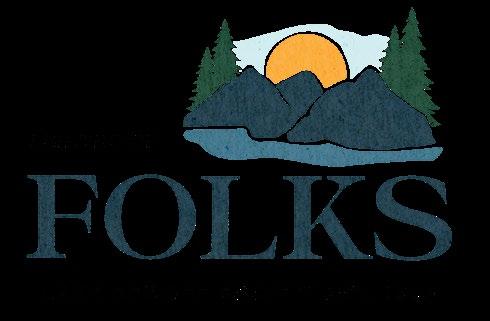
We are excited about continuing our stewardship of preserving the lake and serving as stakeholder on important lake and watershed issues. We are focusing our efforts this year on more community engagement and working with local area schools to help them develop meaningful STEM projects. Join our team of volunteers and become a member!

Our membership form is also online at KeoweeFOLKS.org or by scanning the QR code above. Dues and donation are tax-deductible.
FOLKS is a 501(c)(3) public service watershed organization.
Option for digital copy only of the newsletter







864.638.6642



















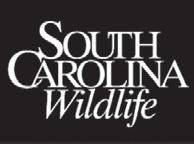




C/O The Alliances
1201 N. Fant St., Anderson, SC 29621
